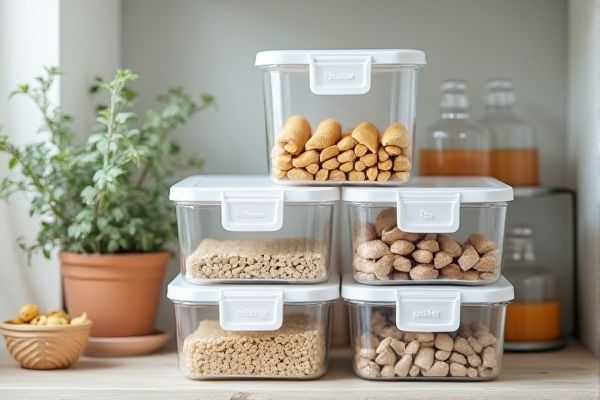
Acrylic bins offer lightweight durability and shatter resistance, making them ideal for environments where safety and ease of handling are priorities, while glass bins provide a sleek, elegant appearance with superior clarity and scratch resistance for a more refined look. Discover which option best suits Your needs by reading the full article.
Table of Comparison
| Feature | Acrylic Bins | Glass Bins |
|---|---|---|
| Material | Durable plastic (acrylic) | Tempered or standard glass |
| Weight | Lightweight | Heavy |
| Durability | Impact-resistant, less prone to shatter | Fragile, can break or chip |
| Transparency | Clear, may scratch easily | Crystal clear, scratch-resistant |
| Maintenance | Easy to clean, avoid abrasive cleaners | Easy to clean, dishwasher safe |
| Cost | Generally affordable | Typically more expensive |
| Eco-friendliness | Non-biodegradable, recyclable | 100% recyclable, eco-friendly |
| Use Cases | Organizing, lightweight storage | Food storage, display, decorative uses |
Acrylic Bins vs Glass Bins: An Overview
Acrylic bins offer lightweight durability and shatter resistance, making them ideal for high-traffic areas or environments prone to accidental drops. Glass bins provide a clearer, more elegant appearance with superior scratch resistance but tend to be heavier and more fragile. Choosing between acrylic and glass bins depends on balancing aesthetic appeal with practical considerations such as weight, durability, and safety.
Material Composition and Properties
Acrylic bins are made from polymethyl methacrylate (PMMA), a lightweight, impact-resistant plastic known for its clarity and shatterproof nature, making them ideal for durability and safe handling. Glass bins, composed of silica-based materials, offer superior scratch resistance and a more premium look but are heavier and prone to breakage upon impact. Your choice depends on whether you prioritize lightweight resilience or elegant, scratch-resistant qualities.
Durability and Break Resistance
Acrylic bins offer superior durability and break resistance compared to glass bins, making them ideal for high-traffic or rough handling environments. Acrylic material is shatterproof, significantly reducing the risk of injury or damage if dropped, whereas glass bins can easily crack or shatter upon impact. Choosing acrylic bins enhances safety and ensures long-lasting use for your storage needs.
Weight and Ease of Handling
Acrylic bins weigh significantly less than glass bins, making them easier to handle and transport, especially for larger storage needs. Their lightweight nature reduces the risk of injury during lifting and minimizes strain on shelves and storage units. Glass bins, while more fragile and heavier, offer sturdiness but require more caution and effort in handling due to their weight and brittleness.
Aesthetic Appeal and Design Options
Acrylic bins offer a modern, sleek appearance with a variety of colors and shapes, enhancing contemporary decor with lightweight and shatter-resistant qualities. Glass bins provide a timeless, elegant look with crystal-clear transparency and smooth finishes, complementing both classic and minimalist interior styles. The diverse design options of acrylic allow for customization, while glass bins excel in delivering a premium, high-end aesthetic.
Safety Considerations
Acrylic bins offer superior impact resistance compared to glass bins, reducing the risk of shattering and injury in environments with high traffic or accidental drops. Glass bins, while more scratch-resistant and visually clear, can break into sharp shards, posing a significant safety hazard. Choosing acrylic bins for your storage needs enhances safety without compromising on aesthetic appeal or durability.
Cleaning and Maintenance
Acrylic bins offer lightweight durability and resist shattering, making them easier to handle during frequent cleaning, and they can be cleaned with mild soap and water without worrying about scratches. Glass bins, while prone to breakage, provide a more scratch-resistant surface and are dishwasher safe, which can simplify maintenance but require careful handling to prevent chips and cracks. Both materials demand regular cleaning to prevent residue buildup, but acrylic's flexibility and impact resistance often translate to lower maintenance concerns in busy environments.
Cost Comparison
Acrylic bins generally cost significantly less than glass bins, making them a budget-friendly option for storage and organization. The production process of acrylic materials is cheaper and more energy-efficient, contributing to lower retail prices compared to glass, which involves more intensive manufacturing and higher quality control standards. While glass bins tend to offer a premium look and durability, acrylic bins provide a cost-effective balance of clarity and lightweight convenience.
Common Uses and Applications
Acrylic bins are widely used for organizing office supplies, craft materials, and pantry items due to their lightweight and shatter-resistant properties. Glass bins, favored in laboratories and upscale retail displays, provide superior clarity and chemical resistance, making them ideal for precise storage and presentation. Your choice hinges on the need for durability and visual appeal tailored to specific storage or display requirements.
Environmental Impact and Sustainability
Acrylic bins have a lower environmental impact during production due to their lightweight nature, reducing carbon emissions in transportation compared to heavier glass bins. Glass bins are fully recyclable and can be reused indefinitely without degradation, contributing significantly to sustainability efforts. Your choice affects waste management, as acrylic is less often recycled, while glass supports circular economy practices.
 homyna.com
homyna.com